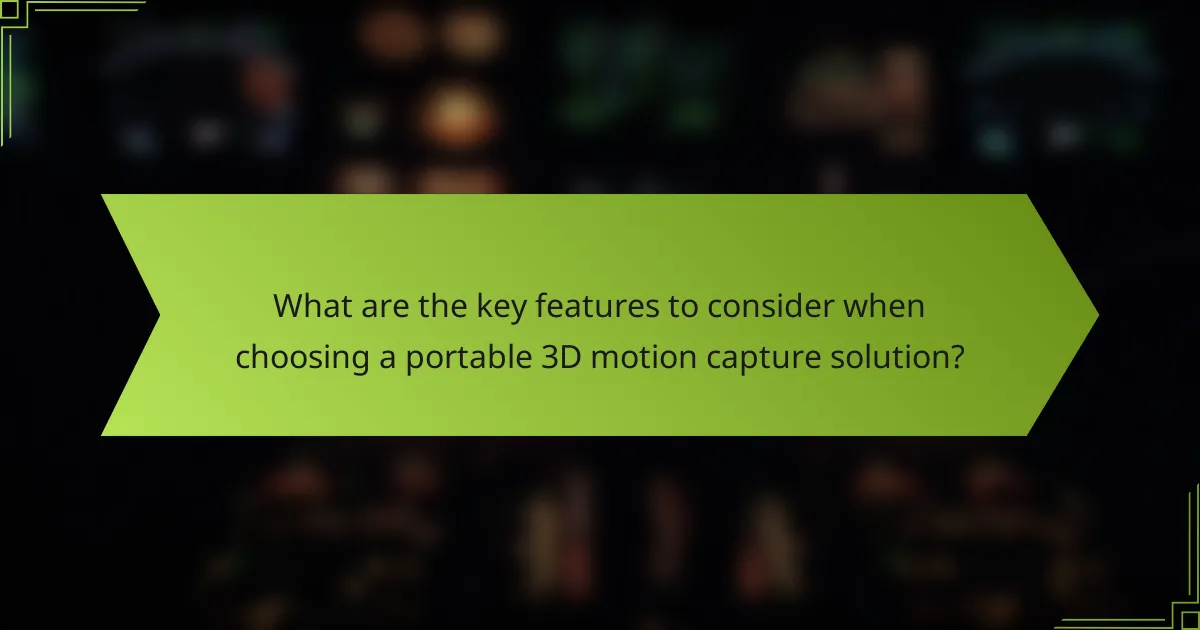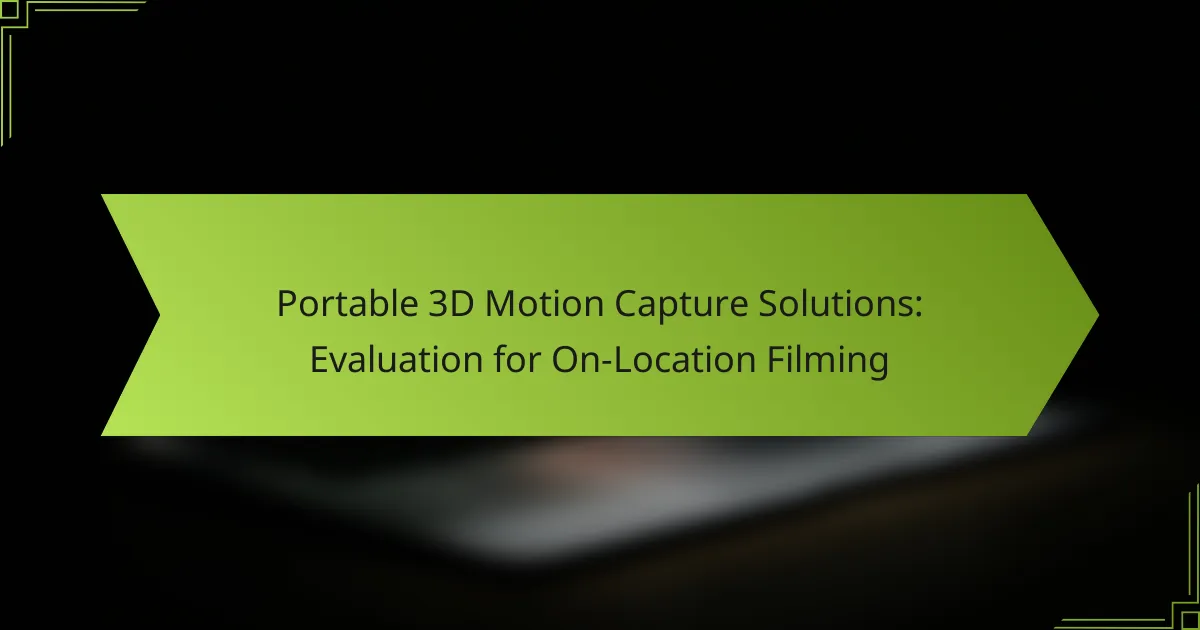Portable 3D motion capture solutions have revolutionized on-location filming by offering lightweight, easy-to-set-up systems that deliver high-quality data. These advanced technologies enable filmmakers to capture real-time motion in diverse environments, enhancing flexibility and efficiency during production. When choosing a system, it’s essential to consider factors such as tracking accuracy, setup time, and software compatibility to ensure optimal performance in various filming scenarios.

What are the best portable 3D motion capture solutions for on-location filming?
The best portable 3D motion capture solutions for on-location filming include systems that are lightweight, easy to set up, and provide high-quality data. These systems are designed to capture motion in various environments, making them ideal for filmmakers who need flexibility and efficiency.
Vicon Vantage
Vicon Vantage is a leading choice for portable motion capture, known for its high precision and reliability. It features advanced cameras that can capture motion data in real-time, making it suitable for dynamic filming environments.
When using Vicon Vantage, consider its setup time and the need for a clear line of sight between cameras and markers. It is particularly effective in controlled outdoor settings where lighting conditions can be managed.
OptiTrack Flex 13
OptiTrack Flex 13 offers a flexible solution for motion capture with its lightweight design and modular setup. This system is ideal for on-location filming, allowing for quick adjustments and easy transport.
Key considerations include its ability to capture data in various lighting conditions and its compatibility with various software platforms. OptiTrack Flex 13 is well-suited for projects requiring rapid deployment and adaptability.
Motion Analysis Cortex
Motion Analysis Cortex is a comprehensive motion capture solution that excels in both indoor and outdoor environments. It provides robust data processing capabilities and is known for its accuracy in capturing complex movements.
When using Cortex, ensure you are familiar with its software interface, as it can be complex for new users. This system is particularly beneficial for projects that require detailed biomechanical analysis.
Perception Neuron
Perception Neuron is a cost-effective motion capture solution that utilizes inertial sensors to track movement. Its portability makes it an excellent choice for filmmakers working in diverse locations.
While Perception Neuron is easy to set up, be aware that it may require post-processing to refine the captured data. It is ideal for smaller projects or independent filmmakers looking for an affordable option.
Xsens MVN
Xsens MVN is a sophisticated motion capture system that combines inertial and magnetic sensors for high accuracy. It is particularly effective in challenging environments where traditional optical systems may struggle.
Consider the calibration process, as it is essential for achieving optimal results. Xsens MVN is suitable for professional productions that demand high-quality motion data and can accommodate its more complex setup requirements.

How do portable 3D motion capture systems work?
Portable 3D motion capture systems utilize various technologies to track and record the movement of objects or people in real-time. These systems can be used on-location for filming, providing flexibility and efficiency in capturing performances without the constraints of traditional setups.
Marker-based tracking
Marker-based tracking involves placing physical markers on the subject being captured. These markers are typically reflective or have unique patterns that cameras can easily identify. The system uses multiple cameras to triangulate the position of each marker, translating their movements into 3D data.
This method is highly accurate and is often used in professional settings, such as film and animation. However, it requires careful setup and calibration, and the markers can sometimes obstruct the subject’s appearance, which may not be ideal for all filming scenarios.
Markerless tracking
Markerless tracking eliminates the need for physical markers by using computer vision algorithms to analyze the subject’s shape and movement. This approach relies on depth sensors or standard cameras to capture the subject’s motion without any additional equipment attached.
While markerless systems offer greater freedom and ease of use, they may struggle with accuracy in complex environments or with fast movements. They are particularly useful for applications where the subject’s appearance is crucial, such as in live performances or interactive media.
Inertial sensors
Inertial sensors use accelerometers and gyroscopes to track motion by measuring changes in velocity and orientation. These sensors are often lightweight and can be attached directly to the subject, making them highly portable and easy to set up.
While inertial systems can provide real-time data and are less affected by environmental factors, they may accumulate drift over time, leading to inaccuracies in long recordings. They are best used in conjunction with other tracking methods to enhance overall precision and reliability.

What are the key features to consider when choosing a portable 3D motion capture solution?
When selecting a portable 3D motion capture solution, key features include tracking accuracy, setup time, portability and weight, and software compatibility. These factors significantly impact the usability and effectiveness of the system in on-location filming scenarios.
Tracking accuracy
Tracking accuracy is crucial for capturing precise motion data. Look for systems that offer sub-millimeter accuracy to ensure the fidelity of the captured movements. Consider the technology used, such as optical or inertial systems, as they can affect the level of detail and reliability in various environments.
For instance, optical systems may provide higher accuracy in controlled settings, while inertial systems can perform better in dynamic or outdoor locations. Always check user reviews and case studies to gauge real-world performance.
Setup time
Setup time can vary widely among portable motion capture solutions. Systems that require extensive calibration or complex configurations may lead to delays on set. Aim for solutions that can be ready to capture in under 15 minutes to maximize filming efficiency.
Consider features like pre-configured settings or automated calibration processes, which can significantly reduce setup time. A quick setup allows for more flexibility in shooting schedules and can accommodate spontaneous changes during filming.
Portability and weight
Portability and weight are essential for on-location filming, especially in challenging environments. A lightweight system that can be easily transported and set up will enhance mobility and reduce fatigue for the crew. Look for solutions that weigh less than 10 kg for optimal convenience.
Additionally, consider the design of the equipment. Compact and foldable systems can save space and make transportation easier. Always evaluate how the system fits into your existing gear and transport methods.
Software compatibility
Software compatibility is vital for integrating the motion capture data into your production workflow. Ensure that the system is compatible with popular editing and animation software, such as Unity, Unreal Engine, or Maya. This compatibility allows for seamless data transfer and reduces the need for additional conversion steps.
Check if the solution offers an open API or supports standard file formats, which can enhance flexibility in post-production. Being able to easily incorporate motion capture data into your projects can save time and improve the overall quality of the final product.

What is the pricing range for portable 3D motion capture solutions?
The pricing for portable 3D motion capture solutions varies significantly based on features and capabilities, typically ranging from a few thousand to over twenty thousand dollars. Budget-conscious filmmakers can find basic systems for under $5,000, while advanced setups with extensive features can exceed $20,000.
Budget options under $5,000
Budget options for portable 3D motion capture solutions generally include entry-level systems that offer basic functionality. These systems often utilize simpler tracking methods and may have limitations in terms of accuracy and range.
Examples of budget systems include handheld devices or software that can work with standard cameras. While these options are cost-effective, they may not provide the precision required for high-end productions.
Mid-range solutions $5,000 – $20,000
Mid-range solutions typically offer a balance of quality and affordability, featuring improved tracking capabilities and better integration with various filming equipment. These systems often support multiple cameras and provide enhanced data processing for more accurate motion capture.
Filmmakers in this range can expect to find systems that include additional features such as real-time feedback and more robust software for post-production. This price range is suitable for independent filmmakers or small studios looking to enhance their production quality without breaking the bank.
High-end systems over $20,000
High-end portable 3D motion capture systems are designed for professional use, offering top-tier accuracy, extensive features, and advanced technology. These systems often include multiple cameras, sophisticated tracking algorithms, and high-resolution data capture.
Investing in a high-end system is ideal for large productions or projects requiring the utmost precision, such as feature films or video games. These solutions often come with comprehensive support and training, ensuring that users can maximize their investment.
